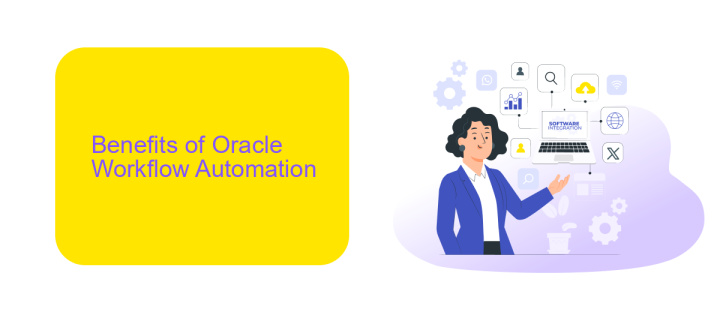Oracle Workflow Automation
Oracle Workflow Automation streamlines business processes by automating repetitive tasks and enhancing efficiency. This powerful tool integrates seamlessly with Oracle applications, providing a robust platform for managing complex workflows. By reducing manual intervention, Oracle Workflow Automation helps organizations save time, minimize errors, and improve overall productivity. Discover how this solution can transform your business operations and drive success in today’s competitive landscape.
Introduction
Oracle Workflow Automation is a powerful tool designed to streamline and optimize business processes. By automating repetitive tasks, it enhances efficiency and reduces the likelihood of human error. This technology allows businesses to focus on more strategic activities, thereby improving overall productivity.
- Automates routine tasks
- Reduces human error
- Enhances productivity
- Enables focus on strategic activities
One of the key features of Oracle Workflow Automation is its ability to integrate seamlessly with various services and applications. Tools like ApiX-Drive facilitate these integrations, allowing businesses to connect Oracle Workflow with other systems effortlessly. This ensures a smooth flow of information and enhances the overall efficiency of business processes.
Benefits of Oracle Workflow Automation

Oracle Workflow Automation offers numerous benefits, significantly enhancing business processes. One of the primary advantages is the reduction of manual tasks, which minimizes human error and increases efficiency. Automated workflows ensure that tasks are completed consistently and on time, leading to improved productivity and better resource management. Additionally, Oracle Workflow Automation provides real-time tracking and monitoring, allowing managers to oversee operations and make data-driven decisions quickly.
Another significant benefit is the seamless integration with other systems and applications. For instance, using services like ApiX-Drive, businesses can effortlessly connect Oracle Workflow Automation with various third-party tools, enhancing data flow and operational synergy. This integration capability ensures that information is synchronized across platforms, reducing data silos and fostering a more cohesive working environment. Overall, Oracle Workflow Automation not only streamlines processes but also supports better collaboration and communication within the organization.
Key Features and Capabilities

Oracle Workflow Automation offers a robust set of features designed to streamline your business processes and enhance productivity. With its user-friendly interface and powerful capabilities, it enables organizations to automate complex workflows effortlessly.
- Seamless Integration: Easily connect with various enterprise systems and applications using ApiX-Drive, ensuring smooth data flow and synchronization.
- Customizable Workflows: Tailor workflows to meet specific business requirements with drag-and-drop functionality and pre-built templates.
- Real-time Monitoring: Gain insights into workflow performance with real-time analytics and reporting tools.
- Scalability: Support for high-volume transactions and complex workflows, making it suitable for businesses of all sizes.
- Security: Robust security features, including role-based access control and data encryption, ensure your data remains protected.
By leveraging Oracle Workflow Automation, businesses can achieve greater efficiency, reduce manual errors, and improve overall operational effectiveness. Whether you're a small business or a large enterprise, these features provide the flexibility and reliability needed to optimize your workflow processes.
Implementation and Integration

Implementing Oracle Workflow Automation involves several key steps to ensure a seamless integration with existing systems. First, a comprehensive analysis of current business processes is essential. This helps in identifying areas where automation can bring significant improvements and efficiencies. Once these areas are identified, the next step is to design the workflow automation structure tailored to specific business needs.
Integration is a critical aspect of Oracle Workflow Automation. It ensures that the automated workflows can communicate effectively with other enterprise systems. Tools like ApiX-Drive can facilitate this process by providing robust integration capabilities. ApiX-Drive allows for the seamless connection of Oracle Workflow Automation with various third-party applications, ensuring data flows smoothly across platforms.
- Analyze current business processes
- Design tailored workflow automation structures
- Utilize integration tools like ApiX-Drive
- Test and deploy the automated workflows
After the integration is complete, it is crucial to conduct thorough testing to ensure that the automated workflows function as expected. Continuous monitoring and optimization are also necessary to adapt to any changes in business processes or requirements. By following these steps, organizations can effectively leverage Oracle Workflow Automation to enhance productivity and streamline operations.
Use Cases and Success Stories
Oracle Workflow Automation has revolutionized the way businesses handle their processes. For instance, a global financial services company streamlined its loan approval process, reducing the time from weeks to just a few days. By automating repetitive tasks and integrating various systems, the company increased efficiency and minimized human error. Another success story comes from a healthcare provider that used Oracle Workflow Automation to enhance patient data management. This led to faster patient onboarding and improved data accuracy, ultimately enhancing patient care and satisfaction.
In the realm of integration, ApiX-Drive has proven to be a valuable tool. A mid-sized e-commerce business leveraged Oracle Workflow Automation along with ApiX-Drive to seamlessly integrate their CRM, email marketing, and inventory management systems. This integration allowed for real-time data synchronization, leading to more personalized customer interactions and better inventory control. These use cases highlight how Oracle Workflow Automation, complemented by tools like ApiX-Drive, can drive significant improvements across various industries.


FAQ
What is Oracle Workflow Automation?
How can Oracle Workflow Automation benefit my business?
Is it possible to integrate Oracle Workflow Automation with other systems?
What are some common use cases for Oracle Workflow Automation?
How can I get started with Oracle Workflow Automation?
Apix-Drive will help optimize business processes, save you from a lot of routine tasks and unnecessary costs for automation, attracting additional specialists. Try setting up a free test connection with ApiX-Drive and see for yourself. Now you have to think about where to invest the freed time and money!

